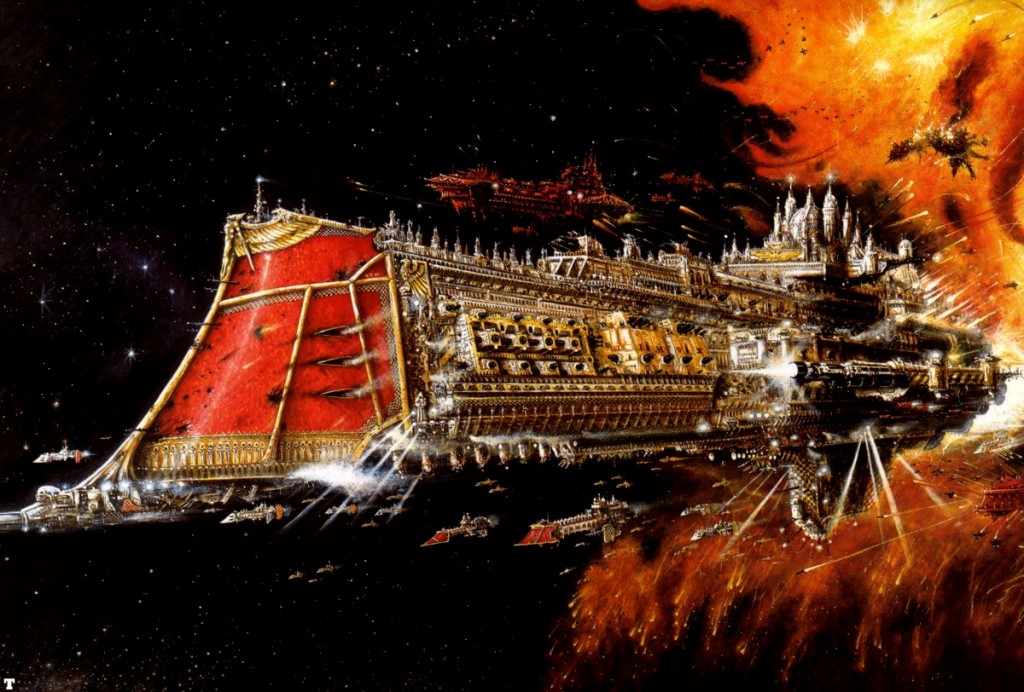Introduction
Battlefleet Gothic is a space naval game produced by Games Workshop set in the Warhammer 40k universe. It was developed and released in the late 1990s, and eventually grew to encompass all of the major factions present in the 40k universe. Battlefleet Gothic, or BFG, as it is commonly abbreviated, was the very first miniatures game I ever played. It is probably the main reason why I am so fascinated by naval games to this day, especially space combat games!
Lack of Official Support
To Put it simply, as far as Games Workshop is concerned, BFG is a dead game. The last new official models (the Adeptus Mechanicus light cruiser, heavy cruiser, and battleship) were released for the game way back in 2007, and it had been several years before that since the last release. About that time, the two player box set for the game was discontinued, making it much less accessible for new players. For a number of years, the game continued on as part of Game Workshop’s beleaguered Specialist Games range, along with Epic, Mordheim, Blood Bowl, Necromunda, and others.. The rules were available online, and minis were available by direct order only, meaning they weren’t sold in stores (outside of existing stock). The entire range (with a few minor exceptions) was available online, and the rules were provided for free download. However, with the re-launch of the Games Workshop website in 2013, all mention of BFG (and the other Specialist Games, for that matter) have been removed. GW seems to have dropped all support for anything other than its “core” games of 40k, Fantasy, and Lord of the Rings. This extends to its Forge World subsidiary, as well. The resin BFG offerings once available off the FW website are now absent.
The Community Steps Up
So does that mean the game is really dead? Not so fast. Even though GW may no longer be supporting the game on its official website, it has developed a very dedicated online community. Without a doubt, the locus for this community is the independently run successor to the Specialist Games forums, Specialist Arms, but there are branches at the major 40k gaming forums like DakkaDakka and Warseer, not to mention the discussions that have popped up here on the Man Battlestations forums. This fan support extends to all sorts of fan projects, including the Warp Rift newsletter, new ships and fleet lists, and even re-writes of the rules. Clearly, many gamers still hold a flame for BFG. The interest in BFG can also be seen in the prices the original miniatures command on eBay and other websites; typically, they go for around twice of what they once fetched at retail, sometimes even more than that. It also doesn’t hurt that the minis for BFG have aged quite well, much better than, say, most of the Epic line. The demand signal has been great enough that several 3rd party sources of BFG-compatible miniatures have sprung up, such as GrimDark Bits on Shapeways, and Battlegroup Helios.
Why The Enduring Popularity?
In some respects, the fact that BFG lives on despite no easy source of miniatures, no advertising, and no support from GW may seem surprising, but I don’t think it really is when you stop and think about it. Part of it is that BFG is THE 40k space combat game, and the 40k the game remains the most popular miniatures game on the market, not to mention the setting itself is tremendously popular. And in some ways, 40k naturally “leads” players to BFG; at some point, your average 40k player is going to start to wonder how his and his opponent’s armies came to be on the same planet. Unlike in Fantasy, 40k armies can’t simply walk everywhere they want to go! Those Drop Pods had to drop from something…
All of that though, would probably not be enough to have kept the game going for this long if the rules weren’t any good. Fortunately, this is not the case. The BFG rules were never bad, though there were a few rough spots in the original edition (the guess-range Nova Cannon rules and Attack Craft rules come to mind!). However, the revised rules, as modified by the 2010 FAQ, really go a long way towards smoothing out those rough edges. The game, as it stands now, is fun, interesting, and fairly well balanced.
In Conclusion
Without a doubt, BFG as a game continues to survive, if not necessarily thrive. The rules, minis, and setting are all compelling enough that it continues to be played. The future is always uncertain; GW seems to have no interest in reviving it as a miniatures game any time soon. However, the miniature designs and fluff from the game have been finding outlets in various other media. Fantasy Flight Games has a supplement for its 40k RPG line called Battlefleet Kronus, for example. FFG has also recently released the Forbidden Stars board game, which uses BFG sculps as some of the playing pieces. Additionally, a BFG video game is under development and due for release in 2016 that looks like it will be a very faithful rendition of the space combat and setting depicted in the BFG rulebook.
In sum, Battlefleet Gothic Is Dead. Long Live Battlefleet Gothic!

